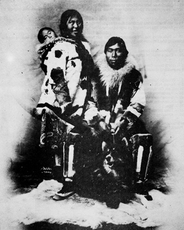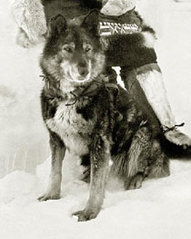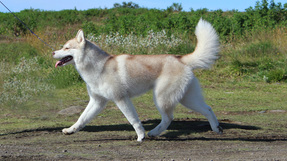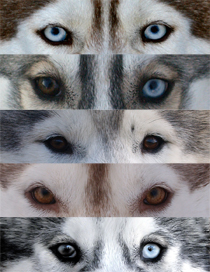
Siberian Husky
The Chukchi people
The origin of the Siberian Husky lies with the Chukchi tribe which, for more than 1,000 years, have inhabited the Arctic coastal region of northern Siberia. The Chukchi dog was bred to withstand extended exposure to low temperature, to pull a light-to-moderate load quickly over long distances, and to extend minimum amount of energy in the process.
The Chukchi valued their dogs so much that they often took them into their homes as guardians of their possessions and as companions for their children. This, no doubt, accounts for much of the gentleness of the Siberian Husky personality.
In the nineteenth century, the Chukchi dog was discovered by Alaskan traders, imported into the Northwest Territory, and renamed Siberian Husky. This importation proved to be very important for the survival of the breed. By the 1930s the forces of Communism in Russia reached the Arctic North. Those tribe members of the Chukchi who bred and maintained the finest dogs had assumed a leadership position and measure of wealth. As hindrances to the forces of collectivization, and most were imprisoned or killed. In just few years, the Chukchi dog breed disappeared from Siberia.
 Togo, one of Seppala's lead
dogs in the Serum
run
Togo, one of Seppala's lead
dogs in the Serum
run
Unlike the breed’s fate in Russia, the Siberian Husky was taking hold in Alaska. Dog sledding had not become only a means of transportation, but also a popular sport. The dogs used in the early dog sledding races were primarily Alaskan sled dogs, originally bred to haul freight. They were larger and stronger than Siberian Huskies, but not as quick. In 1908, when William Goosak came third with his team of Chukchi dogs in the All-Alaska sled race from Nome, the breed became quite famous and many Chukchi dogs were imported from Siberia.
The first sled driver to gain notoriety on the sled dog circuit using Siberian Huskies was Leonhard Seppala. Seppala‘s Siberian Husky teams beat all racers throughout the Northwest. His Huskies were all but unbeatable in the annual 25-mile Border Cub Race in Nome. In January 1925, Seppala and his Huskies earned place in history. During that winter, an epidemic of diphtheria broke out in Nome, and local doctors did not have adequate supplies of the required diphtheria serum. Only connected by a phone and the nearest railway station more than 650 miles away, Seppala was asked to go and collect the serum by dogsled – in a race against time. A relay team of 15 sleds and dogs was sent north with the serum to meet Seppala. Seppala met with the relay team with his team of 20 dogs and retrieved the serum and immediately headed back to Nome. After a long journey through blizzard conditions and cold weather the mission was success.
News reports of the feats of Seppala‘s dogs brought great acclaim to the breed. Many fanciers imported dogs directly from Siberia. These proved to be the last substantial imports before the breed disappeared in its homeland. Today’s Husky that is bred specifically for sled work is slightly stockier and smaller than the specimens seen in the show ring.
Is Siberian Husky the right breed for you?
The first thing to think about before getting a dog is, “do I have enough time?” A breed like the Siberian Husky needs a lot of exercise. An unexercised Siberian becomes bored and lonely easily and may become destructive. If you intend to leave your dog in the backyard all day then don’t get a Siberian. They may prefer the outside to the inside but they need your or other dog’s company. A good owner must train his dog thoroughly in basic commands and supply it with daily love, attention, adequate housing and an outlet for its energy. To thrive, Siberians need companionship, ample space and a good dose of exercise. It will need daily walks; at least one lengthy walk a day with a workout of some kind along the way. They love to camp and hike, walk, jog, and pull sleds and wagons.
To keep a dog is not cheap. Good quality food is not inexpensive, nor is veterinary care! Your dog will need vaccinations, regular checkups, groom supplies, collar, leash, obedience class, etc. And remember to get a dog is a 14 to 15 year commitment, which is not to be taken lightly.
The first sled driver to gain notoriety on the sled dog circuit using Siberian Huskies was Leonhard Seppala. Seppala‘s Siberian Husky teams beat all racers throughout the Northwest. His Huskies were all but unbeatable in the annual 25-mile Border Cub Race in Nome. In January 1925, Seppala and his Huskies earned place in history. During that winter, an epidemic of diphtheria broke out in Nome, and local doctors did not have adequate supplies of the required diphtheria serum. Only connected by a phone and the nearest railway station more than 650 miles away, Seppala was asked to go and collect the serum by dogsled – in a race against time. A relay team of 15 sleds and dogs was sent north with the serum to meet Seppala. Seppala met with the relay team with his team of 20 dogs and retrieved the serum and immediately headed back to Nome. After a long journey through blizzard conditions and cold weather the mission was success.
News reports of the feats of Seppala‘s dogs brought great acclaim to the breed. Many fanciers imported dogs directly from Siberia. These proved to be the last substantial imports before the breed disappeared in its homeland. Today’s Husky that is bred specifically for sled work is slightly stockier and smaller than the specimens seen in the show ring.
Is Siberian Husky the right breed for you?
The first thing to think about before getting a dog is, “do I have enough time?” A breed like the Siberian Husky needs a lot of exercise. An unexercised Siberian becomes bored and lonely easily and may become destructive. If you intend to leave your dog in the backyard all day then don’t get a Siberian. They may prefer the outside to the inside but they need your or other dog’s company. A good owner must train his dog thoroughly in basic commands and supply it with daily love, attention, adequate housing and an outlet for its energy. To thrive, Siberians need companionship, ample space and a good dose of exercise. It will need daily walks; at least one lengthy walk a day with a workout of some kind along the way. They love to camp and hike, walk, jog, and pull sleds and wagons.
To keep a dog is not cheap. Good quality food is not inexpensive, nor is veterinary care! Your dog will need vaccinations, regular checkups, groom supplies, collar, leash, obedience class, etc. And remember to get a dog is a 14 to 15 year commitment, which is not to be taken lightly.
 Vanja on the run
Vanja on the run
Where to get a Siberian Husky
First you have to decide what type you are looking for. Are you looking for a show competitor, a sled dog, or a companion? If you are looking for a potential winner in competitive contests, you need to go through research and make a careful selection. It is good to go to a dog show and get to speak with the breeders of the breed. Not all breeders are working for the betterment of the breed. Be sure to check credentials, and stay clear of anyone who seems more interested in profit than the welfare of this breed. Quality should always be your primary concern, not easy availability. When choosing the right breeder you should be able to ask the breeder questions about him and his dogs, and the breeder should answer truthfully.
When looking at a puppy you should not only look at one puppy, but its litter as a whole. Purchasing the puppy from a poor litter is a risky position. A thriving puppy should be clean and pleasant smelling, its eyes clear and not runny, and there should be no discharge in the ears. The living quarters must be clean, fairly spacious, and parasite-free. Note that the dam just had puppies so she might look worse to wear. If you haven’t seen the dam before you can ask for a photo to see how she looks at her best. Often the sire is not there but you should also be able to see a photo of him. If you are looking for a show dog it is good to check out the puppies’ pedigree and if the parents have had puppies before, then see how those puppies have developed. But remember selecting a puppy destined to be a show dog is always a gamble!!!
Siberian Husky
Siberian Huskies can be fun-loving, energetic clowns, as well as sensitive, intelligent, serious, hard-working dogs.
Like all dogs, they are pack animals and enjoy each other’s company. Within a pack the emerging leader is often referred to as the “alpha” dog. This happens between dog and owner too! A dog will assume that it’s the boss until proven otherwise. Siberian Husky is a spirited breed and undoubtedly will test its owners authority occasionally. They are gentle and peaceful by nature and are rarely antagonistic when encountering another dog.
The breed was built for speed and endurance and when loose they will run very fast, in straight line in the opposite direction from you. They are weak at sensing dangerous situations… and finding their way back home.
Siberians bark less than many other breeds, but when they do vocalize, they tend to woo, howl, sing, chirp, and chatter softly. This gives them a special characteristic trait that makes them somewhat “human” as it sounds like they are trying to talk to you.
Adaptability is he key to the Siberian Husky. They do well in urban and rural settings; no climate is to extreme. They are very well people-oriented, and adapt well to the “human pack”. They are great with children. Tolerant and often very affectionate. They do not display the possessive qualities of the guard dog, nor become overly suspicious of strangers.
Female dogs tend to housetrain more easily, mature sooner, and be less dominant than males. Males are probably more independent and challenging of human authority than females.
Some Siberians are easier to train than others. But when disinterested they do not feign excitement to please its owners. You’ll often need to be inventive and not follow the textbook rules for training. Be ready for a laugh.
Digging
Siberian Huskies are born diggers. Their arctic heritage tells them that digging a hole in the snow is a fine way to keep warm and that digging in the moist ground is a good way to keep cool. And then you can use those body sized hole as a nest and lie down contentedly in it! With the digging comes muddy paws and destroyed flower beds.
All fencing in the yard should be buried to depth that exceeds the digging capability of the dog and about 1,5 – 1,8 m tall. Siberian Huskies are escape artist and can dig a good hole within 30 minutes. They are also very good at manipulating their environment to find a way to jump over lower fences.
Apparence
Height at withers Males:21 to 23,5 inches (53,5 - 60 cm) Females:20 to 22 inches (50,5 - 56 cm)
Weight Males:45 to 60 pounds (20,5 - 28 kg) Females:35 to 50 pounds (15,5 - 23 kg)
Siberian Husky is a beautiful medium sized working dog descending from spitz group. The males are masculine but never coarse; bitches feminine but without weakness of structure.
First you have to decide what type you are looking for. Are you looking for a show competitor, a sled dog, or a companion? If you are looking for a potential winner in competitive contests, you need to go through research and make a careful selection. It is good to go to a dog show and get to speak with the breeders of the breed. Not all breeders are working for the betterment of the breed. Be sure to check credentials, and stay clear of anyone who seems more interested in profit than the welfare of this breed. Quality should always be your primary concern, not easy availability. When choosing the right breeder you should be able to ask the breeder questions about him and his dogs, and the breeder should answer truthfully.
When looking at a puppy you should not only look at one puppy, but its litter as a whole. Purchasing the puppy from a poor litter is a risky position. A thriving puppy should be clean and pleasant smelling, its eyes clear and not runny, and there should be no discharge in the ears. The living quarters must be clean, fairly spacious, and parasite-free. Note that the dam just had puppies so she might look worse to wear. If you haven’t seen the dam before you can ask for a photo to see how she looks at her best. Often the sire is not there but you should also be able to see a photo of him. If you are looking for a show dog it is good to check out the puppies’ pedigree and if the parents have had puppies before, then see how those puppies have developed. But remember selecting a puppy destined to be a show dog is always a gamble!!!
Siberian Husky
Siberian Huskies can be fun-loving, energetic clowns, as well as sensitive, intelligent, serious, hard-working dogs.
Like all dogs, they are pack animals and enjoy each other’s company. Within a pack the emerging leader is often referred to as the “alpha” dog. This happens between dog and owner too! A dog will assume that it’s the boss until proven otherwise. Siberian Husky is a spirited breed and undoubtedly will test its owners authority occasionally. They are gentle and peaceful by nature and are rarely antagonistic when encountering another dog.
The breed was built for speed and endurance and when loose they will run very fast, in straight line in the opposite direction from you. They are weak at sensing dangerous situations… and finding their way back home.
Siberians bark less than many other breeds, but when they do vocalize, they tend to woo, howl, sing, chirp, and chatter softly. This gives them a special characteristic trait that makes them somewhat “human” as it sounds like they are trying to talk to you.
Adaptability is he key to the Siberian Husky. They do well in urban and rural settings; no climate is to extreme. They are very well people-oriented, and adapt well to the “human pack”. They are great with children. Tolerant and often very affectionate. They do not display the possessive qualities of the guard dog, nor become overly suspicious of strangers.
Female dogs tend to housetrain more easily, mature sooner, and be less dominant than males. Males are probably more independent and challenging of human authority than females.
Some Siberians are easier to train than others. But when disinterested they do not feign excitement to please its owners. You’ll often need to be inventive and not follow the textbook rules for training. Be ready for a laugh.
Digging
Siberian Huskies are born diggers. Their arctic heritage tells them that digging a hole in the snow is a fine way to keep warm and that digging in the moist ground is a good way to keep cool. And then you can use those body sized hole as a nest and lie down contentedly in it! With the digging comes muddy paws and destroyed flower beds.
All fencing in the yard should be buried to depth that exceeds the digging capability of the dog and about 1,5 – 1,8 m tall. Siberian Huskies are escape artist and can dig a good hole within 30 minutes. They are also very good at manipulating their environment to find a way to jump over lower fences.
Apparence
Height at withers Males:21 to 23,5 inches (53,5 - 60 cm) Females:20 to 22 inches (50,5 - 56 cm)
Weight Males:45 to 60 pounds (20,5 - 28 kg) Females:35 to 50 pounds (15,5 - 23 kg)
Siberian Husky is a beautiful medium sized working dog descending from spitz group. The males are masculine but never coarse; bitches feminine but without weakness of structure.

The coat is double and medium in length and gives well-furred appearance. The undercoat is soft and dense and of sufficient length to support the rainproof outer coat. The woolly undercoat serves as the dog’s insulation against cold and heat, and a layer of longer, harsher outer coat grows through the undercoat. Shedding will occur at least once a year in males and twice (generally spring and fall) in females. High humidity or excessive heat often will make the shedding worse. The shedding process is about 3-6 weeks, with a new coat growing in during the next 3-4 months. In the shedding season the hair comes out in clumps and everything the dog touches will be covered with hair. The Siberian’s coat remains clean year round and should not take on a “doggy” odor. They also keep themselves clean, those essential self-cleaning machines. The coat may be any color – or any combination of colors – from pure white to pure black (http://www.huskycolors.com/). Most have a striking mask on their face.
Eyes may be any color – brown, blue, or part blue and part brown all in one eye (parti-colored). The eyes may also be green or amber. The eyes should be almond-shaped.
The tail is like a fox’s; full and brushy. At times of excitement, the tail often curls over the Siberian’s back (sickle tail). The sickle tail should not be bent either to the left or right but remain curled over the center of the dog’s back.
The Siberian Husky standard can be read here
Eyes may be any color – brown, blue, or part blue and part brown all in one eye (parti-colored). The eyes may also be green or amber. The eyes should be almond-shaped.
The tail is like a fox’s; full and brushy. At times of excitement, the tail often curls over the Siberian’s back (sickle tail). The sickle tail should not be bent either to the left or right but remain curled over the center of the dog’s back.
The Siberian Husky standard can be read here

